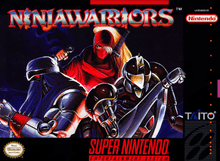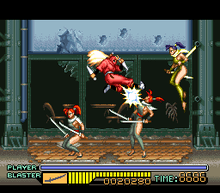The Ninja Warriors (1994 video game)
| The Ninja Warriors | |
|---|---|
 | |
| Developer(s) | Natsume |
| Publisher(s) | Taito |
| Designer(s) | Shunichi Taniguchi |
| Programmer(s) | Toshiyasu Miyabe |
| Artist(s) |
Shunichi Taniguchi Takashi Shinpo Shinya Wada |
| Composer(s) | Hiroyuki Iwatsuki |
| Platform(s) | Super NES |
| Release | |
| Genre(s) | Beat 'em up |
| Mode(s) | Single-player |
The Ninja Warriors[lower-alpha 1] is a beat 'em up video game developed by Natsume and released for the Super NES in 1994. It was published by Taito in North America and Japan, and by Titus in Europe. It is a follow-up to Taito's 1987 arcade game of the same name, and shares similar gameplay. The player can choose between playing as one of three robotic ninjas, and is tasked with helping a rebel faction overthrow an oppressive dictatorship. Each character has different attributes and a unique set of moves including jumps, dashes, throws, and other attacks. The game was developed by the same team at Natsume that later developed Wild Guns (1994).
The game was generally well received by critics. They compared the quality of The Ninja Warriors to Neo Geo and arcade games, and the tight controls and vibrant graphics were universally praised. Journalists disagreed on the quality of several aspects including the difficulty, sound quality, and how well the game distinguished itself among the myriad of beat 'em up games. A remaster is in development for the Nintendo Switch with a planned release in 2019.
Gameplay

The Ninja Warriors is a beat 'em up game that plays in a side-scrolling manner similar to the 1987 arcade game of the same name created by Taito.[5] The player can choose to play as one of three androids with ninja skills: the slow but powerful "Ninja" armed with nunchucks, the quick but weak "Kamaitachi" with sickles on chains, or the balanced "Kunoichi" who wields knives and swords. Per the story, the androids were built by a rebel faction to help them overthrow the tyrant Banglar ruling over their nation. After a sudden attack by Banglar's forces, the rebels had to release the androids to fight, untested.[6]
The player can move along a single plane, with the stages typically going in a linear direction and ending with a boss.[5][6] Each character has a different set of moves which include speed dashes, jumps, grabs, blocks, and a variety of attack moves. There is a power meter that increases slowly with time that, when full, lets the player trigger a powerful attack that damages all enemies on the screen. The meter drains completely if the player is knocked to the ground.[5] Some items, such as motorcycles and large safes, can be picked up and tossed at enemies. The environments occasionally introduce hazards that can hurt the player as well as enemies, such as mine fields or armed helicopters.[6] The Ninja Warriors has eight stages and unlimited continues. The player character can be changed when using a continue.[5][6]
Development and release
The Ninja Warriors was developed by Natsume, specifically the same team that later developed Wild Guns (1994).[1] The team consisted of three core members: game designer and artist Shunichi Taniguchi, programmer Toshiyasu Miyabe, and composer Hiroyuki Iwatsuki.[7][8] Gaming journalists have deemed it both a remake[5][9] and sequel[5][6] of the 1987 arcade original from Taito.[5] The original game was one of Taito's most popular arcade games and set a standard for beat 'em ups.[10]
The game was first released in January 1994 in Japan, published by Taito.[11] Taito localized the game for a release in North America around March/April that same year,[12][13] and Titus published the game in Europe in April 1995.[4] The western localizations featured minor censorship, replacing some female ninja enemies with small male creatures.[5][9] All regional versions of The Ninja Warriors have since become valuable collector's items.[14]
Similar to what they did with Wild Guns, the original team is developing an enhanced remaster of The Ninja Warriors.[15] The game will be titled The Ninja Warriors: Once Again and is slated for release on the Nintendo Switch in 2019. This updated version will include remastered graphics, 16:9 widescreen support, a local two-player cooperative mode, and two new playable characters.[16]
Reception
| Reception | ||||||||||||||||||
|---|---|---|---|---|---|---|---|---|---|---|---|---|---|---|---|---|---|---|
| ||||||||||||||||||
The Ninja Warriors received generally positive reviews. Critics matched its quality to that of Neo Geo and arcade games,[2][10][18] and some wrote that the game was better than the original arcade version.[10][11] GameFan called it Taito's best game to date, and the best game of its kind on the Super NES.[10] Electronic Gaming Monthly called it "the best side-scrolling fighting game yet."[12]
Two aspects of the gameplay that were highlighted by multiple critics were the tight and responsive controls,[3][10][13][18][19] and the variety of each character's moves.[2][10][13] GamePro wrote that it borrowed defensive techniques and interesting offensive combos from fighting games, all of which help set The Ninja Warriors apart from other beat 'em ups.[13] Some believed that the game lacked innovation, and instead fell into a pattern of repetitive gameplay.[3][18][19] In this regard, Mega Fan wrote that the game did not do enough to distinguish itself from Final Fight (1989).[3] Player One and GameFan disagreed, writing that game stands out and keeps the player's interest more than most Final Fight clones.[2][10] The game's level of challenge was both praised as fair,[2][11] and criticized as too easy.[13][19] GamePro wished the game was more difficult, believing it would be easy for veterans of fighting games, and only an intermediate challenge for others.[13] Some other recurring complaints were the lack of a two-player cooperative mode[2][10][12] and the game's short length.[10][17]
Nearly all aspects of the game's graphics were praised, including the colors, shading, backgrounds, animation, and large sprites.[2][3][10][11][12][13][17][18] Player One wrote that the graphics were arcade quality, and the animations were as good as Street Fighter.[2] GameFan wrote that The Ninja Warriors looked like a Neo Geo game, and felt that only the arcade game The Punisher (1993) rivaled its smooth animation.[10] Some believed the sound and music were also of high quality,[3][10][12][13] but they were criticized by others.[2][18] Super Play wrote that "the only thing worth criticizing about this game is the sound", and complained about the weak grunt noises coming from enemies when they are hit.[18]
Retrospective reviews have continued to be positive. Retro Gamer wrote that its variety and presentation make The Ninja Warriors one of the best beat 'em ups.[9] AllGame felt that the game's components were not noteworthy individually, but that it was greater than the sum of its parts, calling it "an old-school, side-scrolling fighter done right."[20] GameFan felt that the game was "unapologetic in its assimilation of the genre standards. If it wasn’t so pretty, it’s likely we would hold that against it."[6] Both Hardcore Gaming 101 and GameFan cited the game's lack of cooperative gameplay as one of its biggest weaknesses.[5][6] The female ninja Kunoichi has gained some recognition. Electronic Gaming Monthly listed her among their list of "Top Ten Fighting Women",[21] and GamesRadar+ listed her among the best ninja assassins in video games.[22]
Notes
- ↑ The game was titled The Ninja Warriors Again in Japan.[1] In western coverage, the game was primarily referred to as The Ninja Warriors[2][3] although the European box art reads Ninja Warriors: The New Generation[4]
- ↑ Average of five individual reviewer scores of 8, 8, 8, 8, and 9.
- ↑ Average of four individual reviewer scores of 87, 86, 93, and 92.
- ↑ Average of component scores of 4.5 for graphics, 4 for sound, 4 for control, and 4.5 for "fun factor".
References
- 1 2 "ワイルドガンズ". Shooting Gameside (in Japanese). Vol. 5. GameSide. May 2012. ISBN 978-4896373899. (Translation Archived July 6, 2018, at the Wayback Machine.)
- 1 2 3 4 5 6 7 8 9 10 "Tests: The Ninja Warriors" (PDF). Player One (in French). No. 52. April 1995. pp. 94–95. Archived (PDF) from the original on July 7, 2018.
- 1 2 3 4 5 6 7 "Ninjawarriors" (PDF). Mega Fun (in German). July 1995. p. 77. Archived (PDF) from the original on May 23, 2018.
- 1 2 "Ninja Warriors : The New Generation sur Super Nintendo". Jeuxvideo.com (in French). Archived from the original on July 19, 2017. Retrieved July 7, 2018.
- 1 2 3 4 5 6 7 8 9 Kalata, Kurt. "Ninja Warriors, The (SNES)". Hardcore Gaming 101. Archived from the original on July 6, 2018. Retrieved July 6, 2018.
- 1 2 3 4 5 6 7 Crisman, Michael (August 13, 2011). "Ninja Warriors RETROspective". GameFan. Archived from the original on September 10, 2011.
- ↑ "TENGO PROJECT". NatsumeAtari (in Japanese). Archived from the original on July 7, 2018. Retrieved July 7, 2018.
- ↑ Natsume (1994). The Ninja Warriors. Taito. Scene: End credits.
- 1 2 3 Yiu (October 8, 2010). "Ninja Warriors Again". Retro Gamer. Archived from the original on September 26, 2015.
- 1 2 3 4 5 6 7 8 9 10 11 12 13 "The Ninja Warriors Again". GameFan. Vol. 2 no. 4. April 1994. pp. 15, 54. Archived from the original on July 7, 2018.
- 1 2 3 4 "The Ninja Warriors" (PDF). Electronic Gaming Monthly. Vol. 6 no. 10. October 1993. p. 74. Archived (PDF) from the original on April 1, 2016.
- 1 2 3 4 5 6 "The Ninja Warriors" (PDF). Electronic Gaming Monthly. Vol. 7 no. 4. April 1994. pp. 38, 144–145. Archived (PDF) from the original on July 7, 2018.
- 1 2 3 4 5 6 7 8 9 "ProReview: The Ninja Warriors". GamePro. May 1994. pp. 58–59. Archived from the original on July 7, 2018.
- ↑ Massey, Tom (January 25, 2015). "A guide to gaming's most valuable treasures". Eurogamer. Archived from the original on November 12, 2017. Retrieved July 7, 2018.
- ↑ "Taito Is Resurrecting Ninja Warriors For Switch And Has More Classic IP In Development". Nintendo Life. July 4, 2018.
- ↑ Romano, Sal (September 5, 2018). "Ninja Warriors Again for Switch officially titled The Ninja Warriors: Once Again, launches worldwide in 2019". Gematsu. Retrieved September 6, 2018.
- 1 2 3 "Ninja Warriors" (PDF). Play Time (in German). August 1995. p. 103. Archived (PDF) from the original on July 7, 2018.
- 1 2 3 4 5 6 7 Leach, James (June 1994). "Import Review: Ninja Warriors". Super Play. No. 20. pp. 54–55.
- 1 2 3 "Now Playing: Ninja Warriors". Nintendo Power. Vol. 59. April 1994. p. 103.
- ↑ Knight, Kyle. "The Ninja Warriors Again [Japanese]". AllGame. Archived from the original on November 16, 2014.
- ↑ "Top Ten Fighting Women" (PDF). Electronic Gaming Monthly. Vol. 6 no. 12. December 1993. p. 58. Archived (PDF) from the original on May 13, 2016.
- ↑ Reparaz, Mikel (June 23, 2012). "The Top 7... Assassins". GamesRadar+. Archived from the original on September 22, 2013.